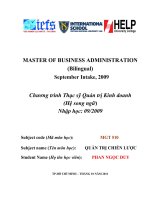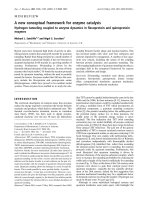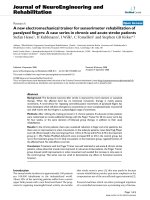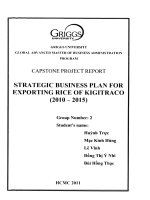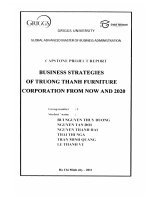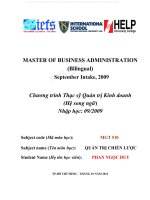Marketing plan for truong thanh agriculture corporation till 2015 master project in business and marketing management
Bạn đang xem bản rút gọn của tài liệu. Xem và tải ngay bản đầy đủ của tài liệu tại đây (195.61 KB, 47 trang )
TRệễỉNG ẹAẽI HOẽC Mễ TP. HCM
HO CHI MINH CITY OPEN UNIVERSITY
UNIVERSITE LIBRE DE BRUXELLES
SOLVAY BRUSSELS SCHOOL
MBMM4
NGUYEN HOANG THANH
MARKETING PLAN FOR TRUONG THANH
AGRICULTURE CORPORATION TILL 2015
MASTER PROJECT
MASTER IN BUSINESS & MARKETING MANAGEMENT
ADVISOR: Dr NGUYEN MINH DUC
HO CHI MINH CITY
(2010)
COMMITMENT
I hereby commit that the paper was written by myself with information
retrieved and obtained from reliable sources and was prepared under the
guidance of Dr. Nguyen Minh Duc. Where ideas were reproduction of other
publication, the sources were clearly indicated, thus assuring no plagiarism
committed.
HCMC, 28 February, 2011
NGUYEN HOANG THANH
ACKNOWLEDGEMENT
I would like to express my sincere thanks to Hiep Quang Co. and Truong
Thanh Corp., for its documents and guidance during my thesis. My deepest
gratefulness goes to the dedicated professors of Solvay Business School –
University of Brussels for the profound knowledge that they managed to
impart to me, for the time they spent with us after class to clarify any hazy
points we might have had, and for the patience they carried with them during
difficult moments when we seemed to disagree with the professors. My
sincere thanks are reserved for Dr. Nguyen Minh Duc, a senior lecturer in
economics at Nong Lam University and Ho Chi Minh City Open University.
Without his invaluable help my paper would never have been finished as it
is now.
I will not forget Mr Serge Bywaski and Ms Nguyen Thi Mong Thuy, our
helpful academic program coordinator, who has been along with us
throughout
the
course
work,
giving
necessary
help
and
enthusiastically as a medium between the class and Solvay professors
HCMC, 28 February, 2011
NGUYEN HOANG THANH
acting
ADVISOR’S REMARKS
The author has selected a good topic related to his expertise in agricultural
business. He has come up in the right direction and complete the proposed
objectives. The marketing plan suggested in useful, realistic and applicable to
direct business activities of the Truong Thanh Corporation going well. The
structure of this project is well-defined with logical and sub-sections.
The author has worked hard to conduct field survey, collect information and do
analyses for this project. With this study, the author has been proved that he had
understood to apply achieved knowledge from MBA program to solve specific
and important problems of the Truong Thanh Corporation.
I believe that this project has been well prepared and studied in a limited time.
Therefore, I strongly recommend the jury to accept his presentation to complete
his master program.
HCM City, 01 March, 2011
Dr. Nguyen Minh Duc
TABLE OF CONTENTS
EXECUTIVE SUMMARY.....................................................................................1
CHAPTER 1 ............................................................................................................3
INTRODUCTION ...................................................................................................3
1.1
Purpose of the Study ....................................................................................3
1.2
Scope of the Study .......................................................................................3
1.3
Methodology and Source of Data ...............................................................3
1.3.1
Desk research .......................................................................................3
1.3.2
Market research....................................................................................3
1.4
Company description ...................................................................................4
CHAPTER 2 ..............................................................................................................6
SITUATION OF ANALYSIS ...................................................................................6
2.1
External Analysis .........................................................................................6
2.1.1
Market analysis ..................................................................................6
2.1.1.1 Market Size .......................................................................................6
2.1.1.2 Market Growth..................................................................................6
2.1.1.3 Market trend .....................................................................................8
2.1.2
SLEPT Analysis ..................................................................................8
2.1.2.1 Social Environment ..........................................................................8
2.1.2.2 Legal Environment ...........................................................................9
2.1.2.3 Economic Environment ....................................................................9
2.1.2.4 Political Environment .....................................................................10
2.1.2.5 Technology Environment ...............................................................10
2.1.3
Competitors Analysis .......................................................................10
2.1.3.1 Suppliers (Bargaining Power Supplier): Medium .........................11
2.1.3.2 Buyers (Bargaining of Power Buyers): High.................................11
2.1.3.3 Potential Entrants (Threats of new entrants): High .......................12
2.1.3.4 Substitute (Threats of Substitute Product or Service): low ...........12
2.1.3.5 Industry Competitors (Rivalry among existing firms): High .........12
2.1.4
2.2
Customers Analysis ..........................................................................13
Internal Analysis ........................................................................................14
2.3
Company Environment: SWOT analyzing ...............................................15
2.3.1
Strengths............................................................................................15
2.3.2
Weakness ...........................................................................................15
2.3.3
Opportunities ....................................................................................16
2.3.4
Threats ...............................................................................................16
2.4
Key success factors....................................................................................16
2.4.1
Company ...........................................................................................17
2.4.2
Customers..........................................................................................17
CHAPTER 3 ............................................................................................................19
MARKETING PROGRAM...................................................................................19
3.1
Marketing Objectives ................................................................................19
3.2
Marketing Strategy ....................................................................................19
3.2.1
Targeting ...........................................................................................19
3.2.2
Re-Positioning ...................................................................................20
3.3
Marketing Mix ...........................................................................................20
3.3.1
Product Strategy ..............................................................................21
3.3.2
Price Strategy ...................................................................................22
3.3.3
Promotion Strategy ..........................................................................22
3.3.4
Distribution Strategy .......................................................................23
3.4
Convincing target customers .....................................................................24
3.4.1
Strengthen sales force team ...........................................................24
3.4.2
Field action plan ...............................................................................24
3.5
Sales Forecast ............................................................................................24
3.6
Implementation and Monitoring................................................................25
3.7
Monitoring and assessment .......................................................................27
CONCLUSION .........................................................................................................28
REFERENCES
APPENDIX
ABBREVIATION
Truong Thanh Corp
: Truong Thanh Agriculture Corporation
Hiep Quang Co.,
: Hiep Quang Co., Ltd
B2B
: Business to Business
B2C
: Business to Customer
GDP
: Gross Domestic Product
DDGS
: Dried Distiller Grains with Soluble
LIST OF FIGURES & TABLES
Figure 2.1: Imported values of animal feed and ingredients in 2008 – 2009
(million USD)
Figure 2.2: Number of animal feed production factories
Figure 3.1: Sales forecast
Table 2.1: Feed for livestock industry
Table 3.1: Customers segmentation
Table 3.2: Quality of Soybean
Table 3.3: Quality of Soybean meal
Table 3.4: Sales forecast
Table 3.5: Milestone
1
EXECUTIVE SUMMARY
Truong Thanh Corp. is a member of Hiep Quang Co., one of the leading
companies in supplying feed ingredients in Vietnam. Truong Thanh Corp.
specializes in trading ingredients for animal feed and aqua-feed production.
Sale volume in its first operating year achieved only 30 percent relative to
proposed plan. This shows that Truong Thanh Corp. is carrying in business
ineffectively.
Current physical assets of Truong Thanh Corp include four depots and one
manufacture factory to produce soybean. In order to support Truong Thanh
Corp carries out it business for a stable development, we have done a
marketing plan for it till 2015 with following contents:
- To 2015, the objective of Truong Thanh Corp is covering up 9 percent
of market share (50,000 tons/years) of soybeans and becoming one of
five leading companies in soybeans supply in Vietnam;
- Major products include soybeans (about 70 percent of sale volume) and
soybean meal (about 20 percent of sale volume);
- With products of soybean and soybean meal diversified based on
quality and price, Truong Thanh Corp still develop soybean products
serving human nutrition segment (soybean number 1);
- Re-segmenting toward target customers are small production factories,
dealers, wholesaler, marketing strategy is business to business (B2B):.
- Re-positioning Truong Thanh brand based on professional workforce,
diversifying products with good quality and reasonable price;
2
Inter-relationship (society) marketing strategy is emphasized with
maintaining long business relationships as well as establish good
relationships to attracting new customers via an enthusiastic sale team
Sale Forcast of Truong Thanh Corp. till 2015
Others
Sale Forecast
Soybean meal
50.000
Soybean
40.000
30.000
20.000
10.000
0
2011
2012
2013
2014
2015
year
3
CHAPTER 1
INTRODUCTION
1.1 Purpose of the Study
Because Truong Thanh Corp is a member of Hiep Quang Co., based on Hiep
Quang’s strategy, this project is implemented:
- To provide a road map and specific guidelines for Truong Thanh Corp.
- To develop product strategy for the corporate based on needs of target
customers.
- To suggest a marketing strategy to achieve its business development
goals in next 5 years
1.2 Scope of the Study
This study is done for southern market, focusing on the corporation’s
business in feed ingredients supplying. This study does not analysis for
activities in Manufacturing and logistics of Truong Thanh Corp.
1.3 Methodology and Source of Data
1.3.1
Desk research
Secondary data will be collected from journal, magazines, websites,
books, and company’s profile and reports for situation analysis and
SWOT matrix analysis.
1.3.2
Market research
Primary data will be collected via in-depth personal interview with
the company’s staffs, wholesalers, retailers, sales manager in order
to identify factors affecting purchasing decision-making the process
4
customers and to get staff’s comment for a new marketing and
business plan.
1.4 Company description
Truong Thanh Agriculture Corporation was founded in June, 2008 and
located in District 11, Ho Chi Minh City. It is a member of Hiep Quang Co.,
which is one of the leading companies in supplying commodities, such as
soybean meal, meat and bone, fish meal, etc. Target customers of Hiep
Quang Co., are focused on businesses (B2B) such as Cargill, CP, Proconco,
etc.
Truong Thanh Corporation also specializes in trading ingredients for animal
feed and aqua-feed production. Truong Thanh Corp is established with initial
orientation of filling in market which Hiep Quang Co., does not do well.
Therefore, with B2C strategy, target customers of Truong Thanh Corp are
farmer, dealer, wholesalers, etc. Established at the time of economic crisis as
well as insufficient prepared plans and business strategies, Truong Thanh
Corp has many difficulties in competing and developing business in Vietnam
market.
With purpose of taking Truong Thanh Corp to overcome bad effects from the
economic crisis period and to develop in the future, the leaders of Truong
Thanh Corp has decided to reconstruct the sales force as well as develop
strongly Soybeans product which is the major product with 70 percent of
sales. The 30 percent remaining products are soybean meal, wheat pellet
Brand, DDGS, etc.
5
To achieve these objectives, Truong Thanh Corp should prepare a business
plan carefully. Wishing to contribute some ideas to make this business plan
better, I choose the theme “Marketing plan for Truong Thanh
Agriculture Corporation till 2015” to do graduating report in MBMM4.
6
CHAPTER 2
SITUATION OF ANALYSIS
2.1 External Analysis
2.1.1
Market analysis
2.1.1.1
Market Size
According to the Ministry of Agriculture and Rural Development,
the livestock industry need about 17 – 18 million tons per year of
food. However, domestic production only meets 50 percent of the
volume. Vietnamese enterprises have to import up to 50 percent of
ingredients needed from other countries. Especially, Vietnam is still
mostly dependent on imports of soybean, soybean meal, worth
around US$1 billion every year.
Base on the General Statistics Office, Quantities of imported animal
feed and ingredients reached 1.157 billion USD in first six months of
2010. Especially, soybean volume imported 200,900 tons in first six
month 2010. Actually, imported feed ingredients stay in group which
has the highest increase speed.
(Source: Customs head office)
Figure 2.1: Imported values of animal feed and ingredients in 2008 – 2009 (million USD)
2.1.1.2
Market Growth
7
The livestock sector is growing at 8-9 percent per year globally.
Livestock production tends to grow fast in Asia - Pacific area, with
an estimated forecast of 7-8 percent increase in demands for
livestock products in the period 2009 – 2020. In Vietnam, the growth
in the domestic animal feed sector is 15 percent per year.
With GDP growth increased highly, income and consumption
increased, meat consumption annually increased about 8-9 percent.
According to the Ministry of Agriculture and Rural Development, in
2010 total meat production should reach 4,108 thousand tons. The
number is expected to increase 5,279 thousand tons in 2015 and
6,788 thousand tons in 2020.
The animal husbandry in Vietnam has achieved some results on
growth and increased density of livestock in agriculture
Table 2.1: Feed for livestock industry
Indicators
Unit
2001
Number of manufactories
Manufactory 126
2005
2007
2008
205
214
225
Total designed productivity Million Tons 3,313 7,661 10,625 12,310
Quantity of feed produced
Million tons
2,690 5,344 7,776
8,536
8
Number of manufactories
250
205
214
225
240
200
150
126
100
50
0
2001
2005
2007
2008
2009
Year
Figure 2.2: Number of animal feed production factories
2.1.1.3 Market trend
With development of the animal husbandry, livestock, and feed
industries are developing and improved in their innovative capacity.
Therefore, more and more commercial and intensive feed
manufactories join into large – scale production toward an
industrialization.
2.1.2
SLEPT Analysis
2.1.2.1
Social Environment
Agriculture is an important economic sector of Vietnam. Currently,
Vietnam is still an agricultural country, with 72 percent of its
population live and work in rural areas, especially in small farm.
With 86 millions of total population, domestic demand consumption
of Vietnam market has a big potential to increase in animal &
aquaculture production. The fact of that average income per capita
9
is still low (1,200 USD per year) but increasing also creates a
potential domestic market for animal and aquaculture products.
With more than 64 millions of population are under 36 years old,
human resource of Vietnam is very young. They are able to access
scientific-technological progress while the labor cost is still low is an
advantage to develop agricultural industries in Vietnam.
2.1.2.2
The
Legal Environment
Circular
122/2010/TT-BTC
of
the
Vietnam
Treasury
Department regulated to take ingredients and feed for animal in
valorization group. When supplying animal ingredients companies
and feed production companies want to increase selling price, they
must register with Office of Price Management of the Treasury
Department.
2.1.2.3
Economic Environment
Vietnam participated in the World Trade Organization in 2007. This
helps import and export goods easier.
Although the global economic crisis since 2008 influenced to
Vietnam’s economy, it is forecasted to come out panic gradually
with GDP growth up to 6.75 percent in 2010. Hence, the industries
tend to recover quickly, especially in agricultural industries such as
animal breeding and aquaculture.
The rate of inflation reached 11.75 percent in 2010 and lower
limited credit constrained to import raw ingredients for animal and
aqua feed production, especially for small and medium enterprise.
10
Alongside with that, interest rate ranges about 14 percent-20 percent
per year also make more difficulties for enterprises to do business.
In foreign exchange market, USD/VND exchange rate is increasing.
Exchange rate increased about 8 percent in 2010 relative to that in
2009. This limited goods and ingredients imported into Vietnam.
The importing companies also faced more troubles when domestic
banks tighten financial credit in lending with importers who operate
in the agricultural field.
However, per capita income growth in Vietnam reached 1160 USD
per year, enforcing demand and purchasing power for agricultural
products
2.1.2.4
Political Environment
Vietnam is considered one of countries occupying stable political
environment in the world. However, Vietnam is still facing with big
problems in corruption.
2.1.2.5
Technology Environment
In Vietnam, technology in livestock industry is too outdated.
Livestock production is scattered and still in small-scale systems.
2.1.3
Competitors Analysis
The analysis of competitors for Truong Thanh Corp. follows Five Forces Model
suggested by Michael Porter
11
New entrants: High
International & domestic
competitors with
tremendous finial Strength
Bargaining power of
supplier
(medium)
Many suppliers
Various ingredients
Industry competitors
(very high)
Bargaining power of
buyer
(high)
There are 38 companies in
2010 in Vietnam
Medium & small
enterprise and farmers
easily shift among 38
companies
Threat of substituted
products
(low)
High cost for conversion
Difficult to find substituted
ingredients
2.1.3.1
Suppliers (Bargaining Power Supplier): Medium
There are many suppliers in animal feed ingredients industry.
Therefore, the supply of animal ingredients is very large. So, the
pressure of suppliers comes essentially from the stability of quality
ingredients in the exporting countries as well as the commitment for
implementing contract of suppliers when the market fluctuates.
2.1.3.2
Buyers (Bargaining of Power Buyers): High
Because of many suppliers, buyers have many choices to select the
best supplier. Pressure of buyers will reduce when buyers need
small quantities of ingredients (such as Farmer or Trading
12
Company) or when ingredients become scarcity or price of
ingredients increases suddenly.
2.1.3.3
Potential Entrants (Threats of new entrants): High
Animal feed production industry has high growth rate (about 15
percent). Besides, corporations and big companies have an
understanding clearly of the market (such as Bunge, Cargill, etc.)
and have strong distribution systems (such as Quang Dung company,
Cargill, etc.). Hence, domestic and foreign companies are very
interested in internal ingredients field.
2.1.3.4
Substitute (Threats of Substitute Product or Service): low
Ingredients for animal feed production industry are essential items.
Thus, substitution from others products is very low.
2.1.3.5
Industry Competitors (Rivalry among existing firms): High
Many competitors are operating in feed ingredient supplying
because of some following reasons:
- Feed ingredient supplying sector has high growth rate (about 15
percent).
- Trading in feed ingredients supplying sector is dispersed (no
company dominates the market).
- Animal feed market has nearly 20 types of feed ingredients to
trade. Therefore, companies can select key products easily.
- Competitive pressures in this branch will be reduced when
ingredients become rare in the market or appear demand of new
ingredients such as wheat bran, Soybeans, ect.
13
2.1.4
Customers Analysis
According to survey results, market distribution of feed ingredients in South
of Vietnam has four major customer groups:
- Big feed mills: including animal feed manufacturing factories with
production over 10,000 tons per month (CP, Cargill, Proconco, Sunjin, etc.):
They buy and import directly about 60 percent - 80 percent feed
ingredients volume from foreign countries. The rest of ingredients are
bought from domestic distributors. According to the surveys, these
companies will choose suppliers who have reputation and stick business
relationship with these companies.
- Small feed mills: including animal feed manufacturing factories with
prodduction under 8,000 tons per month (Vina, Farmtech, Blustar, etc.):
They bought about 50 percent commodities from domestic distributors.
According to the surveys, these companies will choose suppliers who have
stable source & quantities, affordable price, good relationship with these
companies.
The trading & commercial companies, dealer, wholesaler: Most of
customers are intermediators in feed and feed ingredient industry. They
have good finance as well as clear understanding the local market. They
usually buy ingredients when the market become scarcity or selling price
of ingredients has increasing signal. They buy in batches to speculate and
sell out. According to surveys, this group of customer tends to buy feed
ingredients with the best price, ingredients source needed or even
speculation.
14
Farmers and Market Store: this group needs regular and stable ingredients
sources. In addition, this group will buy if ingredients are ensured quality
with reasonable price and have good relationship.
2.2 Internal Analysis
Truong Thanh Corp is a member of Hiep Quang Co.,. Therefore, Truong
Thanh Corp has financial support as well as ensuring input ingredients from
Hiep Quang Company.
Truong Thanh Corp have consulting and supporting from Hiep Quang’s
experts who have understanding clearly about domestic ingredients market.
Furthermore, Hiep Quang Co. has ten years experience in buying and selling
ingredients for animal feed production.
Good logistic system: Truong Thanh Corp and Hiep Quang Co. have four
depots (Bourbon depot, Thu Duc depot, Linh Xuan depot, Phu My depot)
with area more than 35.000 m2. Four depots are spread from Easthern to
Western South of Vietnam to ensure in delivery.
Because of the global financial crisis as well as unclear business strategy,
business result in 2008 and 2009 of Truong Thanh Corp was only less than 30
percent target. In there, products which relate soybean (Soybeans, Soybean
meal) accounted 90 percent yield.
In 2010, Truong Thanh Corp decided to invest a machine which could
classify Soybeans with production with design capacity of 6 ton/h.
Until 2010, target customers of Truong Thanh Corp are direct farmers, the
commercial & service companies.
15
Truong Thanh Corp has no brand name and reputation in ingredients
supplying market for animal feed production. Truong Thanh Corp has no
effective business strategy.
2.3 Company Environment: SWOT analyzing
2.3.1
Strengths
- Truong Thanh Corp is a member of Hiep Quang Co., which is one
of the leading in supplying commodities. So Truong Thanh Corp
can be active in marshaling ingredients input;
- Truong Thanh Corp has well-trained, creative and self-motivated
workforces who come from Hiep Quang Co;
- Using up logistics system of Hiep Quang Co. to reduce
transportation cost and active in distribution ingredients;
- Truong Thanh Corp have good experts who have specialized
knowledge of livestock and aquaculture;
- More external financial support is available.
2.3.2
Weakness
- Truong Thanh Corp has no well-known brand name in the feed
ingredients market.
- Truong Thanh Corp is a followed business. Therefore, it still has
small business partner;
- Truong Thanh Corp does not have good distribution system;
- Truong Thanh Corp does not have particular market in supplying
ingredients for feed production. “Truong Thanh” is still new brand
on the market;
16
- Truong Thanh Corp hasn’t built specific business strategy as well
as segment target customers clearly.
2.3.3
Opportunities
- Domestic demand of ingredients, especially soybeans, soybean
meal, for feed production companies is high and growing with a
growth rate of 15 percent per year
- Because of dense population (more than 86 million persons) and
increasing income, the domestic consumption market of Vietnam
is expected to have huge potential for development.
- Vietnamese government is always interest in and support a rapid
but sustainable development in agriculture of the country.
2.3.4
Threats
- Imported price of ingredients for animal feed and aqua – feed
production is not stable;
- Animal diseases occur frequently (Blue-ear pig, Foot and mouth
diseases) which affect to farmers’s livelihoods;
- Stricter safety regulations for imported feed ingredients;
- The global financial crisis affect strongly to ingredients market for
animal feed production industry;
- Exchange rate is fluctuating.
- Bank interest rate is high and not stable.
- Stricter lending policies of commercial banks toward agricultural
businesses which operate in supplying raw ingredients for animal
feed production
2.4 Key success factors
17
After analyzing the feed ingredients market, five forces of Michael Porter,
SWOT matrix, I realize factors that make Truong Thanh Corp develop in the
future.
2.4.1
Company
- Thorough understanding of the local and international markets
thanks to Hiep Quang Co., which has 10 years experience in
sourcing and marketing of variety of products and commodities in
Vietnam;
- Truong Thanh Corp has effective customer information system.
Therefore, Truong Thanh Corp can identify target customers and
target distributors as well as has elements that effect to buying
decision of customers;
-
Truong Thanh Corp has logistic which cover South of Vietnam
(four big depots). Besides, customers have good evaluation about
delivery system;
- Truong Thanh Corp decides to set up a machine which can
classify soybeans with production with design capacity of 6 ton/h
to enhance value of soybean and hold market demand.
2.4.2
Customers
- Government is encouraging and supporting for development of
agricultural industry.
- Customer demand of ingredients for feed production increases;
- Customer demand of types of ingredients as well as quality of
ingredients is variety: From high quality ingredients for human
feed production (Soybeans number 1, American soybean meal )
